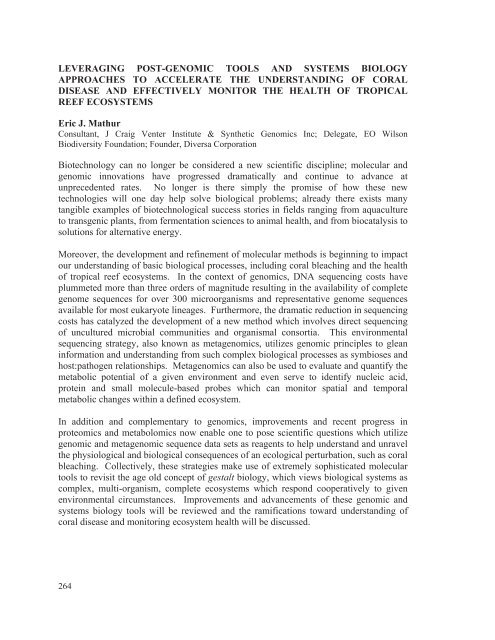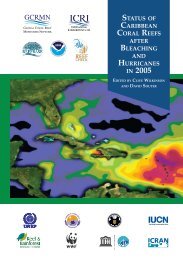Coral Health and Disease in the Pacific: Vision for Action
Coral Health and Disease in the Pacific: Vision for Action
Coral Health and Disease in the Pacific: Vision for Action
You also want an ePaper? Increase the reach of your titles
YUMPU automatically turns print PDFs into web optimized ePapers that Google loves.
LEVERAGING POST-GENOMIC TOOLS AND SYSTEMS BIOLOGYAPPROACHES TO ACCELERATE THE UNDERSTANDING OF CORALDISEASE AND EFFECTIVELY MONITOR THE HEALTH OF TROPICALREEF ECOSYSTEMSEric J. MathurConsultant, J Craig Venter Institute & Syn<strong>the</strong>tic Genomics Inc; Delegate, EO WilsonBiodiversity Foundation; Founder, Diversa CorporationBiotechnology can no longer be considered a new scientific discipl<strong>in</strong>e; molecular <strong>and</strong>genomic <strong>in</strong>novations have progressed dramatically <strong>and</strong> cont<strong>in</strong>ue to advance atunprecedented rates. No longer is <strong>the</strong>re simply <strong>the</strong> promise of how <strong>the</strong>se newtechnologies will one day help solve biological problems; already <strong>the</strong>re exists manytangible examples of biotechnological success stories <strong>in</strong> fields rang<strong>in</strong>g from aquacultureto transgenic plants, from fermentation sciences to animal health, <strong>and</strong> from biocatalysis tosolutions <strong>for</strong> alternative energy.Moreover, <strong>the</strong> development <strong>and</strong> ref<strong>in</strong>ement of molecular methods is beg<strong>in</strong>n<strong>in</strong>g to impactour underst<strong>and</strong><strong>in</strong>g of basic biological processes, <strong>in</strong>clud<strong>in</strong>g coral bleach<strong>in</strong>g <strong>and</strong> <strong>the</strong> healthof tropical reef ecosystems. In <strong>the</strong> context of genomics, DNA sequenc<strong>in</strong>g costs haveplummeted more than three orders of magnitude result<strong>in</strong>g <strong>in</strong> <strong>the</strong> availability of completegenome sequences <strong>for</strong> over 300 microorganisms <strong>and</strong> representative genome sequencesavailable <strong>for</strong> most eukaryote l<strong>in</strong>eages. Fur<strong>the</strong>rmore, <strong>the</strong> dramatic reduction <strong>in</strong> sequenc<strong>in</strong>gcosts has catalyzed <strong>the</strong> development of a new method which <strong>in</strong>volves direct sequenc<strong>in</strong>gof uncultured microbial communities <strong>and</strong> organismal consortia. This environmentalsequenc<strong>in</strong>g strategy, also known as metagenomics, utilizes genomic pr<strong>in</strong>ciples to glean<strong>in</strong><strong>for</strong>mation <strong>and</strong> underst<strong>and</strong><strong>in</strong>g from such complex biological processes as symbioses <strong>and</strong>host:pathogen relationships. Metagenomics can also be used to evaluate <strong>and</strong> quantify <strong>the</strong>metabolic potential of a given environment <strong>and</strong> even serve to identify nucleic acid,prote<strong>in</strong> <strong>and</strong> small molecule-based probes which can monitor spatial <strong>and</strong> temporalmetabolic changes with<strong>in</strong> a def<strong>in</strong>ed ecosystem.In addition <strong>and</strong> complementary to genomics, improvements <strong>and</strong> recent progress <strong>in</strong>proteomics <strong>and</strong> metabolomics now enable one to pose scientific questions which utilizegenomic <strong>and</strong> metagenomic sequence data sets as reagents to help underst<strong>and</strong> <strong>and</strong> unravel<strong>the</strong> physiological <strong>and</strong> biological consequences of an ecological perturbation, such as coralbleach<strong>in</strong>g. Collectively, <strong>the</strong>se strategies make use of extremely sophisticated moleculartools to revisit <strong>the</strong> age old concept of gestalt biology, which views biological systems ascomplex, multi-organism, complete ecosystems which respond cooperatively to givenenvironmental circumstances. Improvements <strong>and</strong> advancements of <strong>the</strong>se genomic <strong>and</strong>systems biology tools will be reviewed <strong>and</strong> <strong>the</strong> ramifications toward underst<strong>and</strong><strong>in</strong>g ofcoral disease <strong>and</strong> monitor<strong>in</strong>g ecosystem health will be discussed.264
















